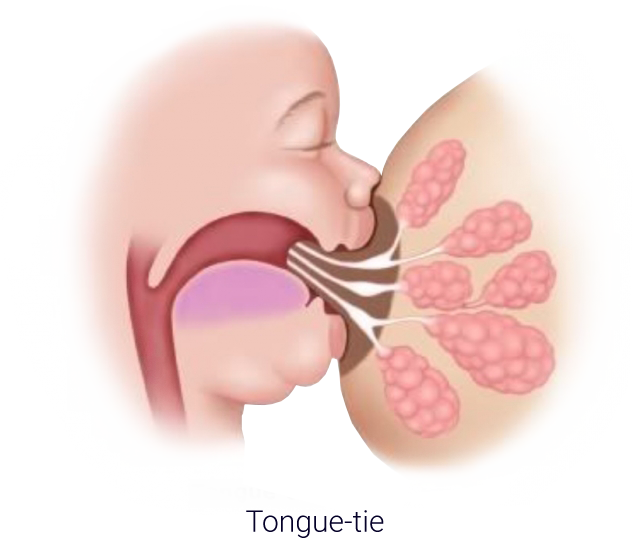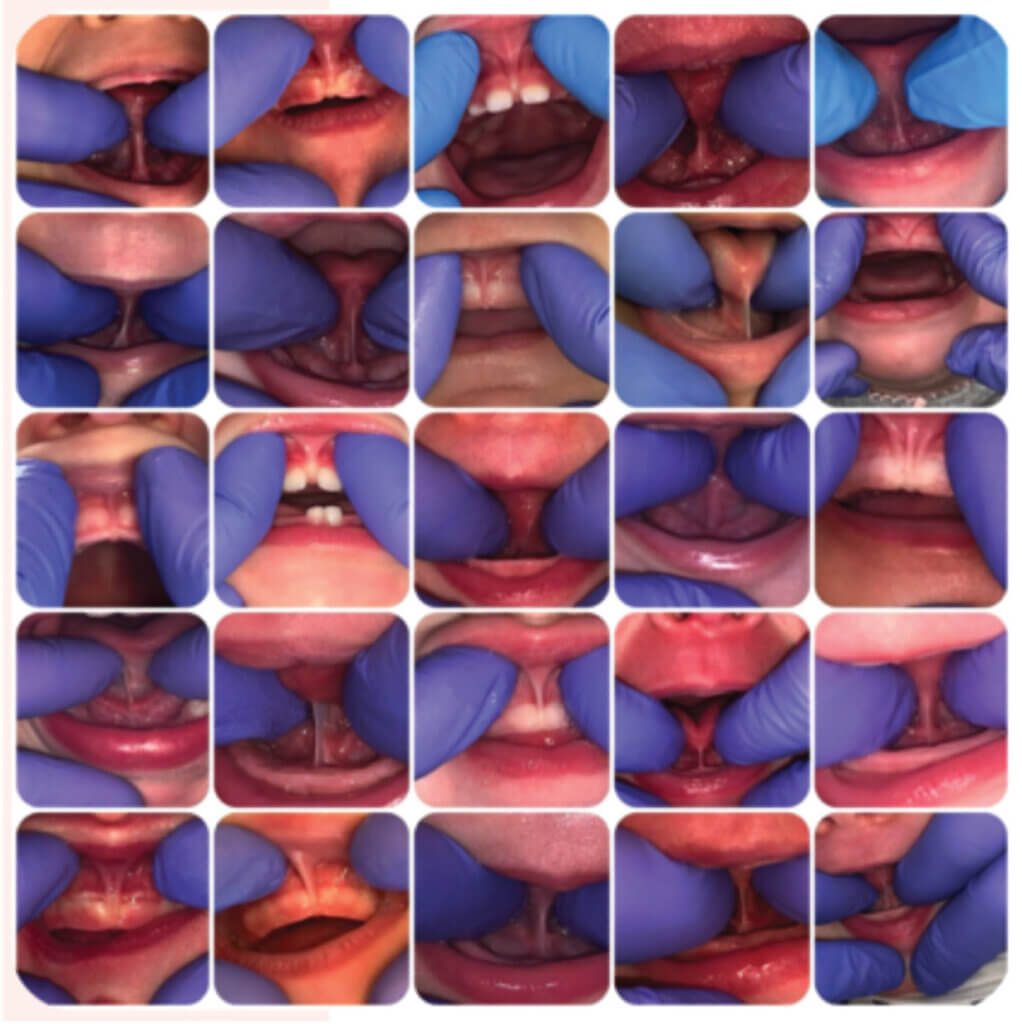INFANT & TODDLER LASER FRENECTOMY
What is a lingual frenulum?
During development, the tongue starts off completely attached to the floor of the mouth. Once the tongue is fully formed in utero around week 8, it begins to separate from the base of the mouth, becoming free to move around. The lingual frenulum is the name given to the connective tissue remnant under the tongue that serves to support and limit its movement in different directions. Yes, every person is born with one!
What is a tongue tie?
For approximately 5-10% of babies, the tongue and floor of mouth separation process is disrupted in utero, leading to an abnormally short frenulum. The presentation can vary widely in thickness, elasticity and specific location on the tongue and floor of the mouth. Sometimes a frenulum may completely tether the tip of the tongue to the edge of the lower jaw. Different presentations may restrict tongue range of motion to varying degrees, and may impact oral motor development, feeding skills and breathing habits even in infancy.
The medical term for tongue tie is “ankyloglossia” and studies show the defect is hereditary. A tongue tie diagnosis and treatment recommendation should be made based upon a true functional limitation. Simply seeing a frenulum under the tongue does not mean it is restricting tongue range of motion. Feeding assessments from appropriate specialists provide crucial insights on a baby’s oral motor skills and it takes an experienced provider to thoroughly investigate anatomical presentation and associated symptoms.
How can a tongue tie affect breast and bottle feeding?


During infancy, the tongue needs full range of motion to create adequate suction to express milk from the breast. The front-mid portion of the tongue draws in, cups and compresses breast tissue while strength and flexibility in the mid-back portion of the tongue is needed to create the negative pressure to remove milk from the breast.
A baby with a tongue tie may be unable to latch deeply onto the breast, leading to possible nipple pain and damage. When the tongue cannot extend up and over the lower jaw, a baby’s latch may feel uncomfortable. Maintaining a latch could pose as a challenge for these babies; some may remain attached to the breast for long periods of time without taking in enough milk.
When the suction is compromised and a baby repetitively loses the seal at the breast or bottle, milk can consistently spill out the sides of the mouth and air may be swallowed, leading to excess gas and fussiness. A tongue tie may impact oral motor coordination and feeding efficiency at the breast or bottle.
What is a labial frenulum?
Just like under the tongue, every baby is born with connective tissue under the upper lip, called the labial frenulum. This tissue helps to anchor the lip to the jaw for proper movement and facial development. Almost 90% of babies are born with a frenulum that attaches to the lower edge of the gum line – the presence of the tissue is normal anatomy. As children get older and the jaw develops, the labial frenulum attachment has been shown to shift upward.
What is a lip tie and how can it affect feeding?
An abnormally tight labial frenulum can disrupt the seal around the breast or bottle nipple, leading to increased air intake – contributing to reflux and gas symptoms or breast pain from the tight upper lip. The lip should play a passive role when a baby is feeding, gently rounding to maintain the seal at the breast or bottle nipple so milk doesn’t spill out. In toddlerhood, a short labial frenulum may impact a child’s comfort forming a seal on a straw or clearing food from a spoon.
This photo gallery illustrates a variety of anatomical presentations of lingual and labial frenula. Some of these babies were diagnosed with tongue or lip ties while others presented with functional, flexible connective tissue allowing for full range of motion. It takes an experienced provider to investigate anatomical presentation (taking into account the variations in clinical appearance), tongue function and associated symptoms.

This photo gallery illustrates a variety of anatomical presentations of lingual and labial frenula. Some of these babies were diagnosed with tongue or lip ties while others presented with functional, flexible connective tissue allowing for full range of motion. It takes an experienced provider to investigate anatomical presentation (taking into account the variations in clinical appearance), tongue function and associated symptoms.
WHY IS TONGUE POSTURE IMPORTANT FOR BREATHING AND OROFACIAL DEVELOPMENT?
In order to direct airflow in and out of the nose, the tongue must be able to rest up against the roof of the mouth. When we breathe through our nose, we can efficiently humidify and filter the air and improve oxygen circulation in our bodies! A tongue tie physically pulls the tongue down towards the floor of the mouth, making it challenging and sometimes impossible to achieve a tongue to palate seal. Low tongue posture may lead to snoring and disrupted sleep patterns.
At rest, the consistent pressure of the tongue against the palate, balanced by the pressure provided by proper lip sealing, serves as a guide for the growth of our upper jaw. Literature shows children with untreated tongue ties may develop abnormal tongue function early in life with a secondary impact on orofacial growth and sleep disordered breathing
Signs and Symptoms of Tongue Ties
While the following symptoms are common amongst babies and their mothers, it is important to note that these signs can be linked to other factors and feeding challenges – they are not solely related to ties.
Babies/toddlers may exhibit:
- Consistent clicking noise during feeds, indicating a repeated loss of suction
- Inefficient, long feeds resulting in exhaustion and frustration
- Leaking of milk from sides of mouth from a poor latch
- Air intake due to a disrupted seal leading to reflux/colic symptoms and gas pain
- Coughing or gagging during feeds from suboptimal coordination patterns
- Snoring, mouth breathing and/or wakeful sleep patterns due to low resting tongue posture
- Difficulty in chewing/swallowing or managing foods/liquids/saliva
Mothers may experience:
- Pain and/or nipple damage resulting from a shallow latch
- Prolonged feeds
- Plugged ducts/mastitis from incomplete breast drainage
- Decreased milk production due to inefficient feeds
Collaborative Care Treatment Approach
Prior to having a tongue or lip tie evaluation, children should be assessed by an International Board Certified Lactation Consultant (IBCLC) or feeding specialist (a trained SLP or OT).
-
Lactation consultants are experts in guiding mothers throughout their feeding journeys and addressing concerns regarding milk supply, latch comfort, breast and bottle feeding techniques, infant feeding patterns, positioning and so much more.
-
Some speech language pathologists or occupational therapists have special training to become experts in pediatric feeding and swallowing; they can assess and address concerns regarding oral tone, strength and oral motor coordination in infancy and childhood.
Working with a functional specialist provides important insight on oral reflexes, postural habits, or speech (if age appropriate) to help differentially diagnose the root cause of the child’s symptoms or to clarify a potential link between a short frenulum and the symptom presentation.
Treatment for tongue and lip ties
A tongue or lip tie release (called a frenectomy) is a minor surgical procedure that removes the tight frenulum, allowing for improved range of motion and flexibility. Because the frenectomy addresses an anatomical limitation, it aids in shifting the physiology in order to reduce or eliminate symptoms.
Many children are able to quickly adapt and thrive following the procedure. Others may take some time to adjust to the new movement and benefit from continued support from an oral motor/feeding specialist to optimize their oral strength and skills. Consideration of other therapeutic modalities may be helpful.
-
A pediatric craniosacral therapist, osteopath or chiropractor can help babies to release tight fascia/muscles that have compensated for a short frenulum or improper suck. Such therapy aims to calm the nervous system and improve structural mobility to assist with latch, feeding, sleep, movement, mood and digestion.
-
A physical therapist or occupational therapist can address range of motion limitations, weak or tense body tone, sensory motor difficulties, and asymmetries in physical development.
Some children may benefit from working with an oral motor or bodywork specialist in preparation for or following the frenectomy procedure. Each case needs to be assessed by a trained practitioner on an individual basis.
Treatment for tongue and lip ties
A tongue or lip tie release (called a frenectomy) is a minor surgical procedure that removes the tight frenulum, allowing for improved range of motion and flexibility. Because the frenectomy addresses an anatomical limitation, it aids in shifting the physiology in order to reduce or eliminate symptoms.
Many children are able to quickly adapt and thrive following the procedure. Others may take some time to adjust to the new movement and benefit from continued support from an oral motor/feeding specialist to optimize their oral strength and skills. Consideration of other therapeutic modalities may be helpful.
-
A pediatric craniosacral therapist, osteopath or chiropractor can help babies to release tight fascia/muscles that have compensated for a short frenulum or improper suck. Such therapy aims to calm the nervous system and improve structural mobility to assist with latch, feeding, sleep, movement, mood and digestion.
-
A physical therapist or occupational therapist can address range of motion limitations, weak or tense body tone, sensory motor difficulties, and asymmetries in physical development.
Some children may benefit from working with an oral motor or bodywork specialist in preparation for or following the frenectomy procedure. Each case needs to be assessed by a trained practitioner on an individual basis.
A Consultation With Dr. Pinto
As an internationally recognized speaker and educator, Dr. Pinto is an advocate for honoring anatomical and physiological normalcies. She educates on proper diagnosis and treatment protocols to 1) avoid unnecessary procedures and over-treatment and 2) to address the importance of establishing optimal oral motor function and tongue posture early on to support feeding, breathing, sleeping, and speaking habits as babies grow.
Dr. Pinto treats children 0-2 and strives to instill a sense of confidence in parents by providing them with the tools and knowledge to guide their child’s oral motor skills, including appropriate therapeutic and lactation/feeding support referrals for a holistic, comprehensive approach.
Dr. Pinto uses a state-of-the-art LightScalpel CO2 laser for a quick, precise, and gentle procedure. The CO2 laser promotes rapid healing and minimizes the risk of bleeding, discomfort, or infection. Topical numbing paste is applied, and the proce- dure takes Dr. Pinto less than 15 seconds. *Dr. Pinto does not use a high heat diode laser or electrocautery.
